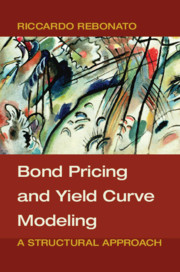Book contents
- Frontmatter
- Dedication
- Contents
- Acknowledgements
- Symbols and Abbreviations
- Part I The Foundations
- 1 What This Book Is About
- 2 Definitions, Notation and a Few Mathematical Results
- 3 Links among Models, Monetary Policy and the Macroeconomy
- 4 Bonds: Their Risks and Their Compensations
- 5 The Risk Factors in Action
- 6 Principal Components: Theory
- 7 Principal Components: Empirical Results
- Part II The Building Blocks: A First Look
- Part III The Conditions of No-Arbitrage
- Part IV Solving the Models
- Part V The Value of Convexity
- Part VI Excess Returns
- Part VII What the Models Tell Us
- References
- Index
2 - Definitions, Notation and a Few Mathematical Results
from Part I - The Foundations
Published online by Cambridge University Press: 25 May 2018
- Frontmatter
- Dedication
- Contents
- Acknowledgements
- Symbols and Abbreviations
- Part I The Foundations
- 1 What This Book Is About
- 2 Definitions, Notation and a Few Mathematical Results
- 3 Links among Models, Monetary Policy and the Macroeconomy
- 4 Bonds: Their Risks and Their Compensations
- 5 The Risk Factors in Action
- 6 Principal Components: Theory
- 7 Principal Components: Empirical Results
- Part II The Building Blocks: A First Look
- Part III The Conditions of No-Arbitrage
- Part IV Solving the Models
- Part V The Value of Convexity
- Part VI Excess Returns
- Part VII What the Models Tell Us
- References
- Index
Summary
Boswell: “He says plain things in a formal and abstract way, to be sure; but his method is good: for to have clear notions about any subject, we must have recourse to analytick arrangement.”
Johnson: “Sir, it is what every body does, whether they will or not. But sometimes things can be made darker by a definition. I see a cow. I define her, Animal quadrupes ruminans. But a goat ruminates, and a cow may have no horns. Cow is plainer.”
Boswell (1791) – The Life of Samuel JohnsonTHE PURPOSE OF THIS CHAPTER
This is not going to be a chapter that will set pulses racing, but it is a useful one. In it we define the financial quantities that we are going to use in the book, we fix our vector notation and we try to clarify possible sources of notational confusion.
We also present (in the appendices at the end of the chapter) some elementary mathematical results that we shall use throughout the book.
THE BUILDING BLOCKS
Arbitrage
For the purposes of this book, an arbitrage is a strategy that is too good to be true – and, therefore, one that in an efficient market does not exist.
A bit more precisely, one says that a strategy is an arbitrage if it costs nothing to set up, if it never produces a negative payoff, and if in at least one possible state of the world it produces a strictly positive payoff.
It pays to look at the definition carefully. First we require that the strategy should cost nothing to set up. Very often, when we buy an asset and sell another to crystallize the value of an arbitrage strategy, the resulting portfolio will not be self-financing – which means that the proceeds from the sale of the asset we are shorting will not exactly match the cost of the asset we want to buy. This means that we must either borrow or lend some money. Since the interest on the borrowing or lending up to the end of the investment horizon of the strategy must be locked in for the strategy to be an arbitrage (why?), this means that we must buy or sell a discount bond. The price of this discount bond is the ‘balancing item’ that makes the initial set-up cost of the portfolio equal to zero.
- Type
- Chapter
- Information
- Bond Pricing and Yield Curve ModelingA Structural Approach, pp. 24 - 48Publisher: Cambridge University PressPrint publication year: 2018



